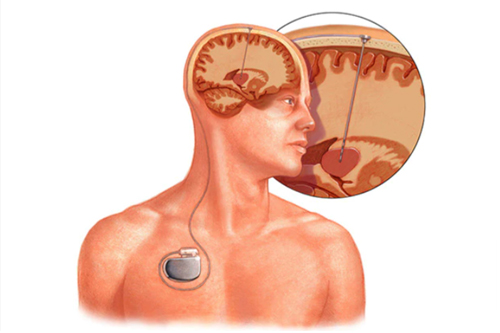
Deep Brain Stimulation
What is Deep Brain Stimulation?
Deep Brain Stimulation (DBS) involves the implantation of electrodes into specific areas of the brain. These electrodes are connected to a small pulse generator, similar to a pacemaker, which sends electrical impulses to regulate abnormal brain activity. The stimulation helps to control symptoms such as tremors, stiffness, and involuntary movements.
Conditions Treated by Deep Brain Stimulation
- Parkinson’s Disease: Reduces tremors, rigidity, and movement difficulties.
- Essential Tremor: Helps control involuntary shaking, particularly in the hands.
- Dystonia: Improves muscle control and reduces involuntary muscle contractions.
- Epilepsy: Helps prevent seizures in some patients.
- Obsessive-Compulsive Disorder (OCD): Provides relief for patients with severe, treatment-resistant OCD.
Benefits of Deep Brain Stimulation
- Effective Symptom Control: DBS provides significant relief from movement disorders.
- Adjustable Treatment: The stimulation settings can be modified to suit the patient’s needs.
- Reversible Procedure: Unlike some surgical treatments, DBS can be adjusted or even removed if necessary.
- Reduced Medication Dependency: Patients often experience a reduction in medication use and its associated side effects.
How is Deep Brain Stimulation Performed?
Electrode Placement
- Subthalamic nucleus (STN) and globus pallidus interna (GPi): Targeted for Parkinson’s disease and dystonia.
- Thalamus: Used for treating essential tremor.
- Anterior nucleus of the thalamus: Primarily for epilepsy treatment.
Implantable Pulse Generator (IPG)
The electrodes are connected to an implantable pulse generator (IPG), a small device typically placed under the skin near the collarbone or in the abdomen. This device continuously delivers electrical impulses to the brain, modulating abnormal activity and alleviating symptoms.
Programming and Adjustment
Following surgery, the DBS system is activated, and its settings are fine-tuned to maximize symptom control. This process, known as “programming,” is conducted over multiple visits to customize the electrical stimulation according to the patient’s specific needs. The intensity, frequency, and duration of the pulses can be adjusted non-invasively using a wireless controller.
What happens after Deep Brain Stimulation In Nagpur ?
After the placement of the pulse generator, your doctor will appoint follow-up in the period of a weeks, where they’ll start programming the pulse generator.
The majority of the modern pulse generators are made with an innate wireless antenna; therefore, your doctor will be able to program it outside your body. Fine tuning may take multiple visits.
Most pulse generators are fitted with specialty long-life batteries. Standard batteries have a shelf life of three to the five years, while rechargeable batteries may last from nine years. Replacing the battery again involves another surgical intervention. Such a procedure is often less traumatic and time consuming than the initial implantation. Patients often leave the hospital the same day after replacing the battery for their stimulator.
The DBS Procedure:
1.Preoperative Imaging and Planning
MRI or CT scans are taken to create a detailed map of the brain and identify the exact location for electrode placement. Advanced imaging techniques help ensure accuracy and minimize risks.
2. Stereotactic Frame or Frameless System
A stereotactic frame may be attached to the patient’s head during surgery to guide the precise insertion of electrodes. In some cases, frameless systems are used for greater patient comfort.
3.Electrode Implantation (Stage 1)
The surgery is typically performed while the patient is awake (for Parkinson’s disease and essential tremor cases) so that doctors can monitor brain activity and symptoms in real time. Small holes are drilled into the skull, and electrodes are inserted into the target areas of the brain.
Neurologists may test the patient’s response during surgery by stimulating the electrodes and assessing improvements in symptoms such as tremors or rigidity.
4.Implantation of the Pulse Generator (Stage 2)
In a second surgical procedure, the pulse generator is implanted under the skin of the chest, and wires from the electrodes are tunneled under the skin to connect with the pulse generator.
5.Postoperative Programming
A few weeks after surgery, the DBS system is turned on, or the electrical stimulation settings are adjusted. This process continues over time as symptoms change or to reduce side effects like speech problems or muscle contractions.
Risks and Complications:
- Infection: There is a small risk of infection at the site of the electrode or pulse generator.
- Bleeding in the Brain: The procedure carries a risk of hemorrhage, which could lead to stroke or other neurological deficits.
- Hardware Malfunctions: The electrodes or pulse generator may malfunction, requiring additional surgery for repair or replacement.
- Side Effects: Electrical stimulation can cause temporary side effects such as:
Best neurosurgeons in nagpur
What is the recovery time?
Most people need a one-day inpatient stay after surgery to have DBS leads implanted into the brain. However, discharge on the same day as surgery to place the pulse generator is often possible.
Recovery is usually three weeks. Your physician likely will have several recommendations for you during that period of time:
For two weeks post-procedure, avoid activity that includes work or household chores and sexual activity. Abstain from lifting objects heavier than 5 pounds (2.25 kilograms).
Avoid any moderate to strenuous exercises or activities for at least four to six weeks, including active exercise and physically demanding work or activities. In most patients, normal daily activity including work may be resumed during this period.
Be careful about moving and stretching, especially a few days after the surgery involving the pulse generator. You’re also supposed to avoid certain movements for some days, such as raising your arms over your head. The degree of restriction and time will depend on the doctor’s specific guidance.Schedule your Consultation with Dr. Ritesh Nawkhare
